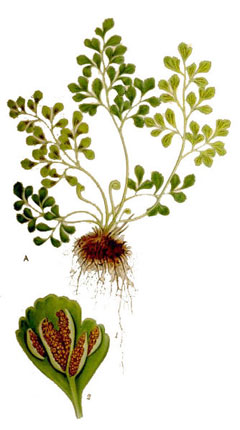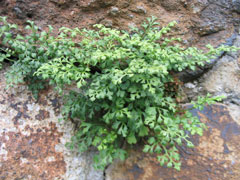 |
|
http://commons.wikimedia.org/wiki/File:Asplenium_ruta_muraria_nf_cleaned.jpg |
 |
| http://commons.wikimedia.org/wiki/User:Hagen_Graebner |
Translate this page:
Summary
Physical Characteristics

 Asplenium ruta-muraria is an evergreen Fern growing to 0.1 m (0ft 4in) by 0.2 m (0ft 8in) at a slow rate.
Asplenium ruta-muraria is an evergreen Fern growing to 0.1 m (0ft 4in) by 0.2 m (0ft 8in) at a slow rate.
See above for USDA hardiness. It is hardy to UK zone 6. It is in leaf all year, and the seeds ripen from July to October.
Suitable for: light (sandy) and medium (loamy) soils and prefers well-drained soil. Suitable pH: basic (mildly alkaline) soils and can grow in very alkaline soils.
It can grow in semi-shade (light woodland). It prefers moist soil.
UK Hardiness Map
US Hardiness Map
Synonyms
Plant Habitats
North Wall. In. East Wall. In. West Wall. In.
Edible Uses
References More on Edible Uses
Medicinal Uses
Plants For A Future can not take any responsibility for any adverse effects from the use of plants. Always seek advice from a professional before using a plant medicinally.
Astringent Deobstruent Emmenagogue Expectorant Ophthalmic
The fronds are astringent, deobstruent, emmenagogue, expectorant and ophthalmic[4, 7, 240]. A distilled water made from the fronds has proved of benefit in the treatment of many eye complaints[7]. The plant is also considered to be useful in the treatment of coughs and ruptures in children[4]. It was at one time used as a herbal remedy for rickets[219] and its tannin content renders it suitable for stopping bleeding from small wounds[7]. The fronds are harvested in late spring and dried for later use[7].
References More on Medicinal Uses
The Bookshop: Edible Plant Books
Our Latest books on Perennial Plants For Food Forests and Permaculture Gardens in paperback or digital formats.

Edible Tropical Plants
Food Forest Plants for Hotter Conditions: 250+ Plants For Tropical Food Forests & Permaculture Gardens.
More

Edible Temperate Plants
Plants for Your Food Forest: 500 Plants for Temperate Food Forests & Permaculture Gardens.
More

More Books
PFAF have eight books available in paperback and digital formats. Browse the shop for more information.
Shop Now
Other Uses
References More on Other Uses
Cultivation details
Requires a well-drained position and lots of old mortar rubble in the soil[1]. Requires a humid atmosphere and some shade[28, 31]. A good plant for growing on a shady part of an old dry-stone or brick wall[K], also succeeding in full sun[219]. A very ornamental fern[1], it is very tough but slow to establish[219]. Members of this genus are rarely if ever troubled by browsing deer[233].
References Carbon Farming Information and Carbon Sequestration Information
Temperature Converter
Type a value in the Celsius field to convert the value to Fahrenheit:
Fahrenheit:
The PFAF Bookshop
Plants For A Future have a number of books available in paperback and digital form. Book titles include Edible Plants, Edible Perennials, Edible Trees,Edible Shrubs, Woodland Gardening, and Temperate Food Forest Plants. Our new book is Food Forest Plants For Hotter Conditions (Tropical and Sub-Tropical).
Shop Now
Plant Propagation
Spores - best sown as soon as they are ripe on the surface of a humus-rich sterilized soil. Keep the compost moist, preferably by putting a plastic bag over the pot. Germinates in spring[1]. Spring sown spores germinate in 1 - 3 months at 15°c[134]. Pot on small clumps of plantlets into individual pots as soon as they are large enough to handle and grow them on in light shade in a cold frame or greenhouse. Keep the plants humid until they are well established. Once the plants are 15cm or more tall, plant them out into their permanent positions in the spring. Division in spring.
Other Names
If available other names are mentioned here
Native Range
TEMPERATE ASIA: Lebanon, Syria, Turkey, Russian Federation-Ciscaucasia (Ciscaucasia), Armenia, Azerbaijan, Georgia, Russian Federation (Dagestan), Kazakhstan, Kyrgyzstan, Tajikistan, Russian Federation (Primorye, Amur), Japan (Hokkaidô, Honshu, Kyushu, Shikoku), Taiwan TROPICAL ASIA: Bhutan, India (Jammu and Kashmir), Nepal, Pakistan NORTHERN AMERICA: Canada (Québec, Ontario), United States (Connecticut, Indiana, Massachusetts, Michigan, New Jersey, New York, Ohio, Pennsylvania, Rhode Island, Vermont, West Virginia, Missouri, Alabama, Arkansas, Kentucky, Maryland, North Carolina, Tennessee, Virginia) EUROPE: Denmark, Finland, United Kingdom, Norway, Sweden, Austria, Belgium, Switzerland, Czech Republic, Germany, Hungary, Netherlands, Poland, Slovakia, Russian Federation (European part), Estonia, Lithuania, Latvia, Moldova, Russian Federation (Volgogradskaja oblast), Ukraine (incl. Krym), Albania, Bulgaria, Bosnia and Herzegovina, Greece, Croatia, Italy, North Macedonia, Montenegro, Romania, Serbia, Slovenia, Spain, France, Portugal
Weed Potential
Right plant wrong place. We are currently updating this section.
Please note that a plant may be invasive in one area but may not in your area so it's worth checking.
Conservation Status
IUCN Red List of Threatened Plants Status :

| Related Plants
|
| Latin Name | Common Name | Habit | Height | Hardiness | Growth | Soil | Shade | Moisture | Edible | Medicinal | Other |
| Asplenium adiantum-nigrum | Black Spleenwort | Fern | 0.5 |
5-9
| | LM | FS | M | 0 | 2 | 2 |
| Asplenium bulbiferum | Hen And Chicken Fern, Parsley Fern, Mother Spleenwort | Fern | 0.3 |
10-11
| S | LMH | SN | M | 1 | 0 | |
| Asplenium ceterach | Scale Fern | Fern | 0.2 |
7-10
| M | LM | FSN | M | 0 | 2 | 2 |
| Asplenium scolopendrium | Hart's Tongue Fern | Fern | 0.6 |
4-8
| S | LM | FS | DM | 0 | 2 | 3 |
| Asplenium trichomanes | Maidenhair Spleenwort, Dense spleenwort, Toothed spleenwort, Brightgreen spleenwort | Fern | 0.4 |
5-9
| M | LM | FS | M | 1 | 1 | 2 |
| Athyrium filix-femina | Lady Fern, Common ladyfern, Subarctic ladyfern, Asplenium ladyfern, Southern Lady Fern, Tatting Fer | Fern | 0.6 |
3-8
| M | LMH | FS | M | 1 | 2 | 2 |
|
Growth: S = slow M = medium F = fast. Soil: L = light (sandy) M = medium H = heavy (clay). pH: A = acid N = neutral B = basic (alkaline). Shade: F = full shade S = semi-shade N = no shade. Moisture: D = dry M = Moist We = wet Wa = water.
Now available:
Food Forest Plants for Mediterranean Conditions
350+ Perennial Plants For Mediterranean and Drier Food Forests and Permaculture Gardens.
[Paperback and eBook]
This is the third in Plants For A Future's series of plant guides for food forests tailored to
specific climate zones. Following volumes on temperate and tropical ecosystems, this book focuses
on species suited to Mediterranean conditions—regions with hot, dry summers and cool, wet winters,
often facing the added challenge of climate change.
Read More
Expert comment
Author
L.
Botanical References
17200
Links / References
For a list of references used on this page please go here
Readers comment
| Add a comment |
|
If you have important information about this plant that may help other users please add a comment or link below. Only comments or links that are felt to be directly relevant to a plant will be included. If you think a comment/link or information contained on this page is inaccurate or misleading we would welcome your feedback at [email protected]. If you have questions about a plant please use the Forum on this website as we do not have the resources to answer questions ourselves.
* Please note: the comments by website users are not necessarily those held by PFAF and may give misleading or inaccurate information.
To leave a comment please Register or login here All comments need to be approved so will not appear immediately.
|
Subject : Asplenium ruta-muraria
|
|
|
|